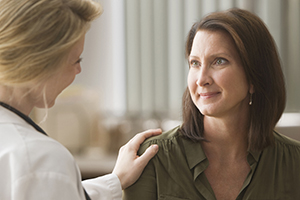Women and heart disease
When it comes to women and cardiovascular disease, significant advances in medical knowledge have been made with intervention and prevention strategies.
Nonetheless, more than 400,000 women will die of heart disease, stroke and other cardiovascular diseases this year in the U.S. About 2,200 women will die per day of this condition — that's two women every three minutes. While one in 30 women dies from breast cancer, one in every three women dies from cardiovascular disease and stroke.

In fact, heart disease, stroke and other cardiovascular diseases will kill more women than the next five causes of death combined.
Unfortunately, women often dismiss their symptoms and signs of a heart attack, or they put off seeing their primary care doctor for routine exams. These delays in care can be life threatening.
"Nearly two-thirds of women who die suddenly of a heart attack did not seek attention for prior symptoms," said Christina S. Reuss, MD, a cardiologist and independent member of the HonorHealth medical staff. "Therefore, educating and empowering our female patients on heart disease is paramount. Heart disease can be prevented."
Signs and symptoms of heart disease in women
A heart attack needs to be recognized quickly because "time is muscle." Heart attack symptoms in women include:
- Shortness of breath with minimal activity (new or unusual change in breathing).
- Pressure or heaviness — some say fatigue — in the upper back, jaw, arms or neck area.
- Unusual, unexplainable profound fatigue or weakness.
- Overall achiness with or without nausea, vomiting, indigestion and cold sweats.
- Chest discomfort: A sensation of aching, tightness or pressure, like the palm of a hand is pushing on the chest. Women are more likely not to experience severe chest pain. What's more, women may not describe this discomfort as pain.
- Feelings of anxiety, loss of appetite and discomfort, a sense of doom.
Evaluation is different with women
When it comes to diagnosis and treatment for heart disease, women are often evaluated in a way that differs from men because:
- Women tend to wait longer than men to go to an emergency room when having a heart attack. That means they're likely to arrive in the emergency room after suffering a lot of heart damage. This impacts the risks/benefits for procedures like coronary angiography.
- Once women do seek medical attention, symptoms sometimes can be misdiagnosed. In part, this is due to the way women present with a heart attack, but it's also due to how women describe and even minimize certain facts.
- Characteristic patterns of chest pain and EKG abnormalities are often less apparent.
- Females tend to be 10 years older than men when they have heart disease symptoms. Women should be proactive about their health and be evaluated for risk factors such as hypertension, diabetes and high cholesterol.
- Women have a higher occurrence than men of chest pain not caused by heart disease. For example, chest pain can be due to a spasm of the esophagus, uncontrolled acid reflux, muscular and skeletal joint pains. However, if you experience chest pain, you should seek medical attention.
"My recommendation for women is that they should be aware of their heart disease risk factors and seek prompt attention for their symptoms," Dr. Reuss said.